Mate!
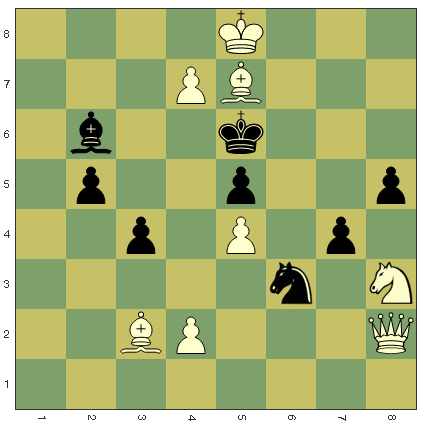
Consider the positional set up of a game. It is white's turn to move. White can checkmate black in just two moves, can you find the first move to force a checkmate?
If the first move can be written as ( x 1 , y 1 ) , ( x 2 , y 2 ) , where x 1 , y 1 are the coordinates (according to how it is marked above) of the moved piece's initial position and x 2 , y 2 are the coordinates of the position of the piece after the move, evaluate ( x 1 + y 1 ) × ( x 2 + y 2 )
The answer is 48.
This section requires Javascript.
You are seeing this because something didn't load right. We suggest you, (a) try
refreshing the page, (b) enabling javascript if it is disabled on your browser and,
finally, (c)
loading the
non-javascript version of this page
. We're sorry about the hassle.
8 solutions
Fun problem and great solution! (+1) You rarely see a chess problem that involves both capture en passant and promotion to a Knight.
Log in to reply
Great problem @Vishnu Bhagyanath , I missed the word "INITIAL". Well done +1 :)
It was fun to solve, and a great solution with lots of diagrams!
- White queen (8,2) takes pawn on (5,5) ; Black knight (6,3) must take queen (5,5)
- White knight (8,3) goes to (7,5) for CHECKMATE
Log in to reply
King retakes instead of knight
After White queen (8,2) takes pawn on (5,5) the Black King can take the White Queen, not the knight
Log in to reply
White Queen is protected by the pawn at (4,4). So The Black Knight has to take on the White Queen.
Log in to reply
@Venkata Praneeth – if the Queen move is the first move, there would be no pawn in (4,4).
If the king takes Q on (5,5) instead knight taking it. What is the next move to mate?
King captures queen instead of knight captures queen.
I just think likes you, and I dont know why its wrong
Log in to reply
The problem with Soutik's solution is that the Knight isn't the only piece that can capture the White Queen. The Black King can ad when it does, it takes at least one more move to mate and so it is not mate in 2.
Also queen from (8,2) can move to (6,2) so that if bishop takes the Queen then you push the pawn on (4,7) and promote to a Knight with checkmate. If bishop doesn't take the queen then any move by black will result in white capturing the bishop with his queen. Although this is a nice problem it sadly did not include this solution. PS I got the problem wrong because of this
Log in to reply
No, this is not going to work. If Black moves the Bishop to 15, 37, or 48, White will be unable to finish the job.
I thought of that but it doesn't work because you can move the bishop to a5, c7 or d8. This new coordinate system is giving me cancer, could we use standard short chess notation possibly?
Got it after a little while of thinking. Looked at lots of possibilities for the first move, but they turned out to be the second. :) Good problem there!
Great problem! Will be waiting for another one like this :)
I loved your last sentence... I kept wondering why the blacks should make all these moves...
What about queen (8,2) to (5,5) ? I think then the black knight will take the white queen and then the black knight can check mate by going from (8,3) to (7,5) ???
Log in to reply
The black king can take the white queen if she moves to (5,5).
Is it possible to have 110 white knight to 6,4 and then queen if knight is killed to 6,4 sry for spoiling ur time if i am missing something...
Log in to reply
Knight to (6,4), Pawn takes Knight, Queen takes pawn.
Is that what you meant?
If so it's not check.
The appropriate response from black is to let white push that pawn and black knight takes the white queen. This results in no checkmate. The best checkmate is the move white's knight from (8,3) to 7,5) This checks the black king forcing black to take the knight with the black knight. Then the checkmate is queen takes pawn, (8,2) to (5,5)
Log in to reply
That "best checkmate" scheme does not work either: The black king will just take the black queen.
I really did enjoy this problem even though I didn't get it at first. I didn't because I completely forgot the the other pieces on the board actually mattered and weren't just roadblocks. Good problem though. Although I see a problem in the solutions. In the problem you said that it was White's turn to move. Yet in your solutions it showed as if it was Black's turn to move. Clarification Please?
Log in to reply
Because white has moved its piece (as it was white's move) a pawn from (4,2) to (4,4) and then this cases are possible, that how black can react after this move :) :)
What if white queen moVes to (4,6) either the bishop (5,5)have to kill it or blacks take another move... If bishop kill the queen knight will lead to checkmate otherwise queen can move to (6,6) leading to checkmate.... Correct me if wrong... @Vishnu Bhagyanath
Log in to reply
First of all, the piece in (5,5) is not a bishop but it is a pawn. If the white queen moves to (4,6), the pawn can capture the queen and black still won't be mated by the knight since the king can still move to (5,5).
This is a nice problem, kind of tricky for a mate in two I thought.
Log in to reply
Composed problems are usually intended to be tricky.
Problems from real games, or those intended to teach tactics are often much easier.
I have found a way to checkmate the king in 1 move. Regardless where the white pawn in 7,4 moves, up or down, the king is lost in a stalemate as no other item is attacking the king.
Couldn't you move the Queen to (6,2)? The black bishop takes the white Queen and then promote the white pawn to a knight, checkmate. Or the black bishop doesn't take and black moves any other piece from what I can see and white queen takes black bishop for checkmate.
Log in to reply
Oh I just saw that the black Knight blocks at (4,4).
Log in to reply
If the black knight blocks, then the white knight can now jump to g5, delivering checkmate as the black knight no longer defends that square. The real reason why David is wrong is because the black bishop can now move to any other square along the a5-d8 diagonal, where there will be no more checkmate.
That's wrong. The black bishop can move to a5, c7, or d8. After this, white will have no immediate checkmate.
Pawn in 4,7 to 4,8. Queen me. Queen to 4,6. Checkmate.
Log in to reply
Black bishop takes queen? You didn't even give black the chance to play.
Log in to reply
well he has to move it quick or else the black bishop would capture it and he'd miss the mating move lol ... but kidding aside, Vishnu is right, black has to move first and the bishop taking queen is the next logical move to stave off mate in the next turn
What if some one takes pawn with bishop and allow white to get qween It will not be the met in 2 then??
Log in to reply
White does not have to promote to a queen. White can choose the piece he wants to promote to. In this case, if you promote to a Knight, white will mate in 2. This is known as underpromotion.
And the black knight on(6,3), can't it eat the white Knight?
And the black Knight on (6,3), can't it eat the white Knight on (7,5)?
You missed another case where nothing captures instead ignores the pawn and plays something else
Can't we mate in one move? Isn't Nf4 mate?
Log in to reply
The knight would be captured by a pawn (exf4).
You can also play Q(4,2) if the black knight captures it you can play your own knight to(7,5) and check mate. If the black knight doesnt captures the queen you can still win by playin Q(8,6)
Case 3 is wrong because , if case three happens then white will take 3 steps to checkmate black
Log in to reply
It is right, promoting pawn at (4,7) to knight directly gives check to black king CHECK and there is no move so its a MATE. :) :)
Case 4 is no checkmate, the queen doesn't check the black king from 4-6, thus no checkmate in 2
Log in to reply
It is checkmate, I think you've confused (4,6) and (6,4)
What about Queen from (8,2) to (5,5), and that would force Knight to kill the queen. And then white Knight to (7,5) will mate in 2 moves too.
Log in to reply
As mentioned to the other people, the Knight doesn't have to recapture, the king can, allowing it to escape the mating net.
Log in to reply
Damn I'm a novice, I only saw the knighting as that is where I looked first and simply went backwards on how to win in 2 moves... didn't see how else I would have won in 2 moves as the question didn't force me to look, but still!
There are 2 ways to solve this in 2 moves at least where initial move is different. I suggest you accept both 100 and 48 are answers. The OP better research and submit. You cannot have two answers.
Log in to reply
The solution of 100 is not valid. The black king can capture the white queen instead of the knight taking. 48 is the only answer.
Well, d2 -d4 !! It would result in
-
en passant cxd3 Bb3#
-
Nxd4 Ng5#
-
exd4 Qd6#
-
Bxd4 d8=N#
mate is forced. End of statement.
Finally! Someone using actual notation. I got one of these wrong a week ago because I couldn't figure out how they wanted the notation, even though the problem itself was simple.
Log in to reply
Apologies, I would've used standard notation but the answers can only be integers, so I decided to keep it this way.
It should be n75, because it would end the game with a win for white.
Three different possibilities: d2-d4 Nf3xh2 d4-d5#/ d2-d4 e5xd4 Qh2-d6#/ d2-d4 c4xd3 Bc2-b3#
1.d4 is the correct move which threatens 2.d5 checkmate.
Black has four options:
1...Bxd4 which allows 2.d8=N checkmate 1...Nxd4 which allows 2.Ng5 checkmate 1...exd4 which allows 2.Qd6 checkmate and 1...cxd3 (e.p.) which allows 2.Bb3 checkmate
Therefore, 1.d4 wins.
To calculate the numerical answer for this problem one would say:
( x 1 + y 1 ) × ( x 2 + y 2 ) = ( 4 + 2 ) × ( 4 + 4 ) = 6 × 8 = 4 8
Funny thing is 1.Ba3 also works. (5,7) (1,3) , 12x4=48.
Yes, more than one first move could give the same correct number. I wonder what better way there is to give numeric solutions to chess problems?
Multiple choice might make the problem too easy.
Log in to reply
Maybe, alphabetical order; for example, B=2, a=1 and Ba3 = 213
No it doesn't work. Bc5 delays mate.
I did the same :) as I have 1800+ rating on chess.com this problem doesn't find to tough for such players :D
Even if it isn't an En passant,the white pawn can mate the king by moving to (4,5).
It is important to note that as of now, the black king has no squares to move to.
It is also important to note that all of blacks pieces are playing more than one role at the moment. Such pieces are called overworked pieces, if they move from their position, it gives white entrance to another position (which can potentially lead to checkmate.)
The move ( 4 , 2 ) ( 4 , 4 ) will achieve checkmate in 2 moves. Why? Let's look at the possibilities.
Case 1 :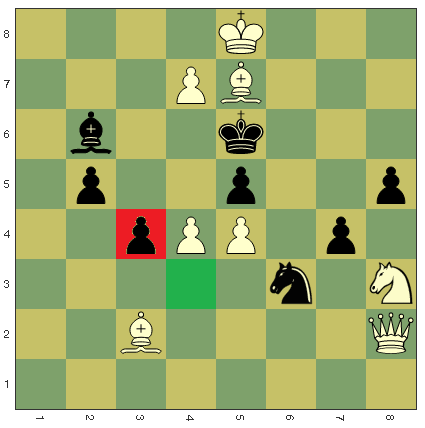 If the marked pawn captures the pawn marked in green (
En passant
) then the bishop situated on
(
3
,
2
)
moves to
(
2
,
3
)
and checkmates black.
If the marked pawn captures the pawn marked in green (
En passant
) then the bishop situated on
(
3
,
2
)
moves to
(
2
,
3
)
and checkmates black.
Case 2: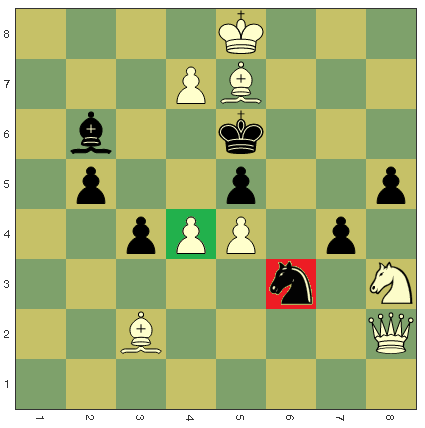
If the marked Knight captures the pawn, the white knight on ( 8 , 3 ) can move to ( 7 , 5 ) and deliver checkmate.
Case 3: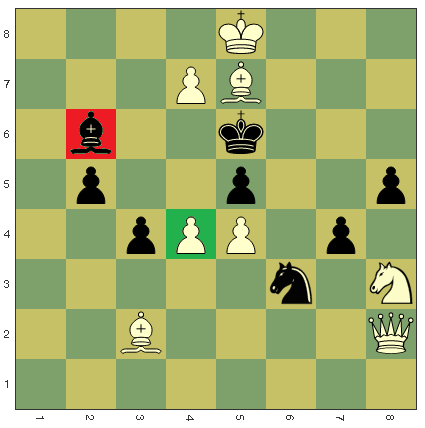
If the bishop captures the pawn as shown in the figure. The pawn on ( 4 , 7 ) can be promoted to a Knight.
Case 4: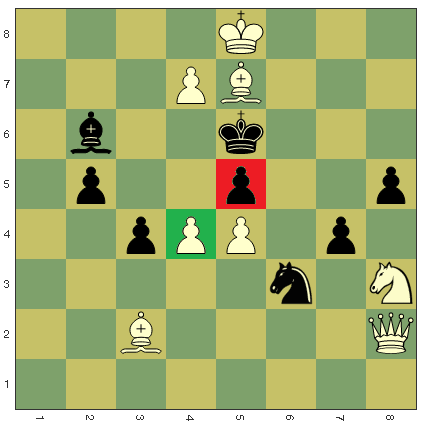
If the pawn captures as shown in the figure, the white Queen can move to ( 4 , 6 ) to checkmate black.
Any other move, the pawn simply pushes forward again and checkmates black.